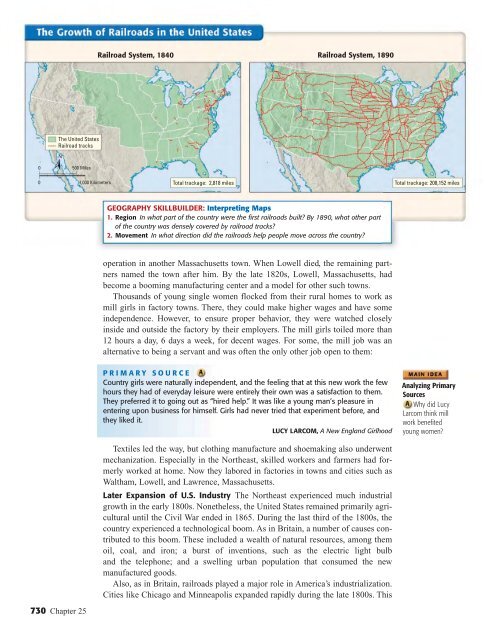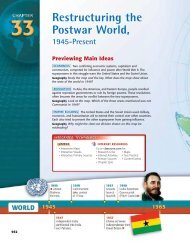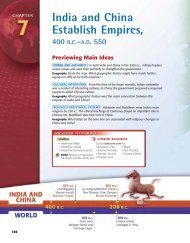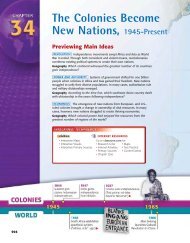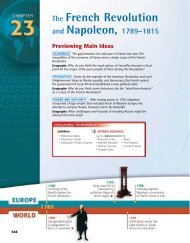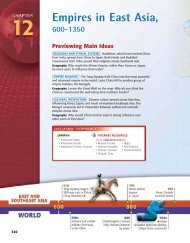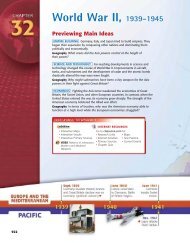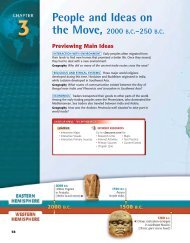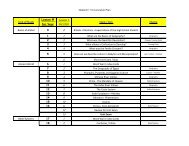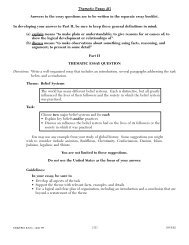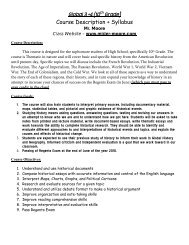The Industrial Revolution, 1700– 1900 Previewing Main Ideas
The Industrial Revolution, 1700– 1900 Previewing Main Ideas
The Industrial Revolution, 1700– 1900 Previewing Main Ideas
Create successful ePaper yourself
Turn your PDF publications into a flip-book with our unique Google optimized e-Paper software.
<strong>The</strong> United States<br />
Railroad tracks<br />
0 500 Miles<br />
0 1,000 Kilometers<br />
730 Chapter 25<br />
Railroad System, 1840 Railroad System, 1890<br />
Total trackage: 2,818 miles Total trackage: 208,152 miles<br />
GEOGRAPHY SKILLBUILDER: Interpreting Maps<br />
1. Region In what part of the country were the first railroads built? By 1890, what other part<br />
of the country was densely covered by railroad tracks?<br />
2. Movement In what direction did the railroads help people move across the country?<br />
operation in another Massachusetts town. When Lowell died, the remaining partners<br />
named the town after him. By the late 1820s, Lowell, Massachusetts, had<br />
become a booming manufacturing center and a model for other such towns.<br />
Thousands of young single women flocked from their rural homes to work as<br />
mill girls in factory towns. <strong>The</strong>re, they could make higher wages and have some<br />
independence. However, to ensure proper behavior, they were watched closely<br />
inside and outside the factory by their employers. <strong>The</strong> mill girls toiled more than<br />
12 hours a day, 6 days a week, for decent wages. For some, the mill job was an<br />
alternative to being a servant and was often the only other job open to them:<br />
PRIMARY SOURCE<br />
Country girls were naturally independent, and the feeling that at this new work the few<br />
hours they had of everyday leisure were entirely their own was a satisfaction to them.<br />
<strong>The</strong>y preferred it to going out as “hired help.” It was like a young man’s pleasure in<br />
entering upon business for himself. Girls had never tried that experiment before, and<br />
they liked it.<br />
LUCY LARCOM, A New England Girlhood<br />
Textiles led the way, but clothing manufacture and shoemaking also underwent<br />
mechanization. Especially in the Northeast, skilled workers and farmers had formerly<br />
worked at home. Now they labored in factories in towns and cities such as<br />
Waltham, Lowell, and Lawrence, Massachusetts.<br />
Later Expansion of U.S. Industry <strong>The</strong> Northeast experienced much industrial<br />
growth in the early 1800s. Nonetheless, the United States remained primarily agricultural<br />
until the Civil War ended in 1865. During the last third of the 1800s, the<br />
country experienced a technological boom. As in Britain, a number of causes contributed<br />
to this boom. <strong>The</strong>se included a wealth of natural resources, among them<br />
oil, coal, and iron; a burst of inventions, such as the electric light bulb<br />
and the telephone; and a swelling urban population that consumed the new<br />
manufactured goods.<br />
Also, as in Britain, railroads played a major role in America’s industrialization.<br />
Cities like Chicago and Minneapolis expanded rapidly during the late 1800s. This<br />
Analyzing Primary<br />
Sources<br />
Why did Lucy<br />
Larcom think mill<br />
work benefited<br />
young women?


